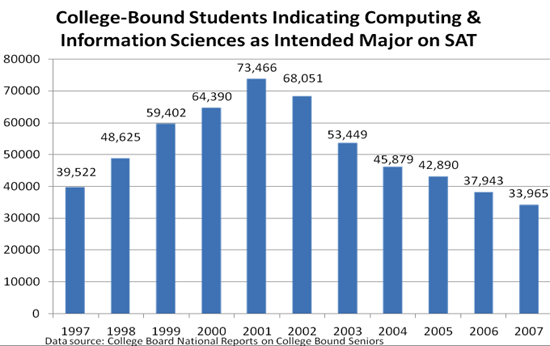THIS IS AN ARCHIVED VERSION OF CRA'S WEBSITE. THIS ARCHIVE IS AVAILABLE TO PROVIDE HISTORICAL CONTENT.
PLEASE VISIT HTTP://WWW.CRA.ORG FOR THE LATEST INFORMATION
| About CRA |
| Membership |
| CRA for Students |
| CRA for Faculty |
| CRA-Women |
| Computing Community Consortium (CCC) |
| Awards |
| Projects |
| Events |
| Jobs |
| Government Affairs |
| Computing Research Policy Blog |
| Publications |
| Data & Resources |
| CRA Bulletin |
| What's New |
| Contact |
| Home |
<<Back to January 2008 CRN Table of Contents
[Published originally in the January 2008 edition of Computing Research News, Vol. 20/No. 1]
Creating a Computer Science Major for Arts & Sciences Students
by David Evans and J. McGrath Cohoon
Undergraduate enrollment in computer science programs dropped precipitously in recent years. The CRA Taulbee survey indicates that the number of new students entering the major in 2006 was half of what it had been in 2000. HERI/UCLA reports similar declines among college freshmen intending to major in computer science. As Figure 1 depicts, the number of college-bound students who intend to pursue a computer science major is at its lowest point in more than ten years.

Most computer scientists find it extremely difficult to reconcile these decreasing enrollments with the exceptional fun, vibrancy, and opportunity we see in our field. Computing seems to suffer from misconceptions that our field is narrow in terms of people who can succeed as computer scientists, the content of computing curricula, and the kinds of careers open to graduates with computer science degrees. To mitigate these misperceptions, we advocate expanding the accessibility of computer science degree programs by creating majors targeted to more students—in particular to non-engineering students.
Many computer science departments reside in schools of engineering, which limits access for non-engineers. Students who enter college without a definitive idea of what field they want to pursue, or who enter with a myriad of interests, may be repelled from engineering because of its highly structured curricula and typical focus on continuous mathematics and physical sciences. At universities where the only way to major in computer science is to enroll in the engineering school, this requirement presents a serious but unnecessary hurdle to pursuing a degree in computing.
Computer science has strong connections to the arts and sciences, as well as to engineering. Our deepest questions concern abstract properties of problems and processes; and most of our main challenges have little to do with physical constraints typically faced by engineers, but rather focus on designing abstractions to manage complexity. Further, applications of computing go beyond the (still important) engineering applications to encompass applications ranging from analyzing genomes to economic modeling to musical composition. This boundary-spanning nature of computing demands broadly educated professionals.
At the University of Virginia, we are expanding access to computing by creating a new Interdisciplinary Major in Computer Science (BA degree) for students in the College of Arts and Sciences. Building on our experience with a non-degree program and minor, the Computer Science Department (which is located in the school of engineering) initiated an effort to create a degree for Arts and Sciences students in fall 2005. A committee (chaired by the first author) was formed consisting of a balanced mix of faculty from computer science and from the College of Arts and Sciences. Having strong involvement from college faculty was essential to both designing a suitable degree program and ensuring there was support for the new degree in the college. The degree was approved in spring 2006, and our first group of 25 students was admitted that spring.
The new degree incorporates many of the existing core courses from the existing engineering school BSCS degree (enough to ensure that graduates obtain a solid and comprehensive computer science education), along with two unique aspects: 1) a new two-course gateway sequence designed to bring students without previous computing experience into the major; and 2) a requirement to complete four “integration electives,” which are selected courses taught by other departments that either cover material deeply related to computing (such as a philosophy course on symbolic logic, math course on number theory, and an economics course on game theory) or connected through applications (such as digital art and music courses and computational science courses).
Our initiative with the BA degree offset the enrollment declines in our BS program, attracting about 25 majors per year. Further, these BA students bring a diversity of thought and breadth of interests into our classes, enriching them with their knowledge and interests in fields such as cognitive science, music, biology, and linguistics. We gain more than numbers when we create a computer science major for Arts and Sciences students.
____________________
David Evans is an Associate Professor and Director of the Interdisciplinary Major in Computer Science at the University of Virginia.
J. McGrath Cohoon is a Senior Research Scientist at the National Center for Women and IT, and Assistant Professor of Science, Technology, & Society at the University of Virginia.
Copyright © 2007 Computing Research Association. All Rights Reserved. Questions? E-mail: webmaster@cra.org.
